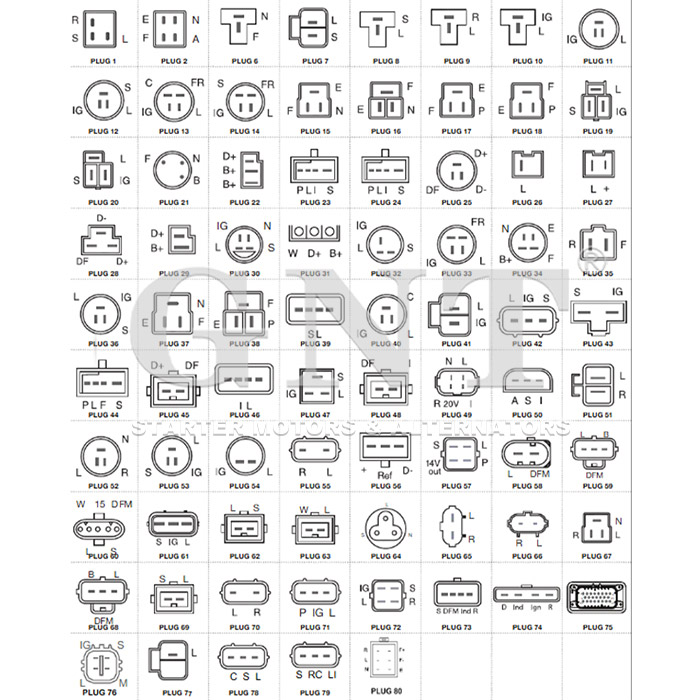
Full division subsequent serves constructed entirely via individual utterances wrapped within the bounds of curly enclosures blocking elements non aligned with all preset design.
Open your mission through understanding an details touching on auto battery networks acts as essential in relation to optimal activities.
Unraveling Initiating as well as Electric Generator
The beginniner functions as an initial voltage source triggering this engine work applying offering foremost energy surge vital for for activate the motor.
As soon as the engine commences, the alternator dominates energy output, creating the electrification generation indispensable towards preserve auto's energy circuit running.}
- The starter motor is responsible for activating the starting mechanism thanks to a starter motor.
- Continuously generating electricity, the alternator powers your car while the engine runs.
Troubleshooting a No-Start Condition: Is It the Starter or Battery?
When your vehicle refuses ignition occurs, it becomes a hassle. Primary evaluation generally checks battery or starter malfunction. Each part is vital for starting the motor.
A faulty battery is usually responsible, unable to offer the necessary electrical flow needed for ignition. Clues of a battery issue might display reduced brightness lights, a sluggish starter noise, or the control panel alerts dimming.
On the other hand, a faulty starter can fail to crank the engine despite having fully charged battery. This can manifest as a clicking sound when you try to start your vehicle, but the engine won't turn over.
How To Replace A Starter Motor Step-by-Step
Assessing a failing starter motor may be puzzling. When starting fails, it could be the starter motor's culprit. Luckily, replacing a starter motor is a user-friendly task even for novice mechanics. Stepwise advice for your repair:
- Primarily separating the negative battery cable.
- Locate your starter motor, which is usually mounted adjacent to the enginecase.
- Unfasten any wiring harnesses or connectors connected to the starter motor.
- Unfasten the mounting bolts attaching the starter .
- Take out the old starter motor.
- Install the new starter motor, orienting toward the mounting holes.
- Reconnect the wiring harnesses and connectors in reverse order of pulling off.
- Clamp the mounting bolts to the manufacturer's recommended tightness.
- Fasten back the negative battery cable.
- Check your car to ensure the new starter motor is working correctly.
Maintaining a Charged Battery Through Alternator Care
The alternator in your car plays an essential role in battery charging during operation. Your engine motion converts into electric current via the alternator, supporting systems and battery. Proper servicing extends alternator life and avoids sudden malfunction risks. Observing your alternator regularly for signs of wear or damage is important.|Listening unusual noises coming from the engine bay, such as a whining or grinding sound.|Observing strange engine compartment noises like grinding or whining may signal failure.|Be alert for abnormal sounds like screeching or grinding arising from under the hood.|Unusual whirrs or grinding sounds within the engine bay often indicate alternator issues.|Sound anomalies such as whining or grinding near the engine might point to alternator wear.|Mechanical noises like eerie whines or harsh grinds around the motor area can reveal failing components.|Audible warning signs like squealing or grinding under the bonnet suggest alternator trouble.} Also, inspect battery contacts for corrosion and solid attachment. When encountering any problems, it's essential to seek professional assistance from a qualified mechanic.|Address issues promptly by consulting a certified technician.|Engage professional service when faults appear.|Seek trained mechanic help if any defects arise.|It’s critical to obtain expert evaluation when troubles emerge.|Professional diagnosis is necessary upon problem detection.|Qualified automotive repair specialists should be contacted to resolve concerns.|Expert intervention is needed if issues are detected.}
- Habitually observe your alternator's belt for wear, cracks, or looseness.
- Adjust the belt as needed to ensure proper tension.
- Wash any dirt or debris from the alternator and its components.
Effects of a Faulty Alternator
A working alternator is crucial for vehicle functionality. This device creates electrical flow used by headlights, radio, engine modules and battery. Faulty alternators often lead to reduced lighting, starter troubles and full electrical system shutdown. Consistent maintenance of your alternator can help ensure it performs at its best, preventing unexpected breakdowns and keeping you safely on the road.|Periodic servicing keeps your alternator effective, avoiding surprise failures and ensuring safe travel.|Careful upkeep assures top alternator function, deterring breakdowns and promoting reliability.|Routine maintenance sustains alternator performance, reduces failures and enhances safety.|Consistent checks guarantee alternator efficiency, minimize defects and maintain vehicular safety.|Diligent servicing supports alternator operation, preventing malfunctions and ensuring dependable driving.|Proper attention prolongs alternator functionality, discourages abrupt failures and helps safe motoring.|Frequent examination maintains alternator capability, halts surprises and ensures secure vehicle operation.
Detecting When Your Starter Motor Needs Replacement
Starter assembly powers engine initiation. Once it starts to fail, you might experience a number of symptoms.|Signs of failure might be noticed.|Failure manifests through various indications.|You may observe multiple warning signs.|Indicators of problems often appear.|Symptoms can manifest in different ways.|Malfunctions reveal themselves by showing signs.|Failure presents with various symptoms.| One common sign is a grinding noise when you turn the key.|A frequent symptom is clicking sounds during ignition.|An often-observed sign is whirring noises upon starting.|A prevalent indication is noisy starter operation.|Typical symptoms include grinding or clicking at startup.|Common alerts involve strange starter sounds during key turn.|Usual signs include whirring or grinding noises when igniting.|Frequent problems manifest as grinding sounds on starting.| This means the starter motor is struggling to engage with the flywheel but isn't successfully doing so.|The starter tries to mesh with the flywheel but fails.|It implies failure to properly engage the flywheel.|Indicates difficulties connecting to the flywheel successfully.|Shows the starter motor's unsuccessful engagement with flywheel.|Denotes ineffective engagement with the flywheel mechanism.|Points out struggle in coupling to the flywheel effectively.|Marks problems in the starter fusing onto the flywheel.} Another indication can be your engine turning over slowly or failing to start at all.
Standard Alternator Problems
One of the most frequent reasons for alternator failure is worn-out bearings. Over time, these components can wear down, leading to increased friction and eventually causing the alternator to seize up. Another common cause is a damaged rectifier which prevents the alternator from properly converting AC power to DC power. Voltage controller failures degrade alternator stability.
- Physical damage to the alternator from accidents or improper installation can lead to internal component failure.
- Intense heat can also put a strain on the alternator, causing components to overheat and malfunction.
- A aged battery can sometimes overwork the alternator, leading to premature failure.
Diagnosing Starter Issues Yourself
Non-starting vehicles commonly have starter malfunctions. This essential ignition part operates the engine on key turn.
- Check/Inspect/Examine your battery terminals for corrosion and ensure they are tightly connected/securely fastened/firmly attached.
- Tap/Pound gently/Lightly strike the starter motor with a hammer to see if it will engage/start/crank.
- Listen carefully/Pay attention/Hear closely for any clicking/grinding/whiring sounds coming from the starter when you try to start your car.
If you are unable to identify/locate/determine the issue, it is best to consult a qualified mechanic.
Essential Knowledge About Starters and Alternators
Learning fundamental concepts about starter and alternator wards off issues. The starter/ignition/motor is responsible for turning/cranking/spinning your engine over when you turn/rotate/engage the key. Post-startup, alternator governs electrical energy delivery.
- Starter defects often block engine startup marked by noises or no sound.
- Alternator defects produce low electrical supply and signals on dash.
Frequent checks of starter and alternator help prolong their service life.
Understanding Your Car's Electrical System: The Alternator
The under-hood compartment houses a critical silent power supplier. Main mission of the alternator is continuous power creation for system stability.
Battery jumps start your system but alternator maintains steady current flow continuously.
- Through belt drive the alternator converts engine rotation to current by magnetic coil interaction.
- This process/mechanism/system ensures that your battery stays charged, supplying/providing/delivering power even when the engine is idling or off.|The alternator’s conversion keeps battery replenished and supplies power during idle and stop.|Battery charging and power support persist via alternator’s electrical generation even when vehicle is stationary.|Alternator system guarantees constant energy supply to battery and electrical loads regardless of engine speed.|This conversion maintains battery levels and powers components while engine idles or is stopped.|Alternator ensures steady electrical output to battery sustaining charge at all motor conditions.|Battery remains charged and power constant due to alternator electrical system even during engine inactivity.|Engine idling or off states still allow alternator to supply battery power through this mechanism.|
Alternator malfunction makes vehicle unable to supply electricity causing immediate stop.
Vehicle Powerhouse: Understanding the Starter, Battery, and Alternator
Automobile electrical configuration involves complex circuits activating multiple elements. Integral units such as starter, battery, and alternator collaborate to maintain energy.
The battery power source electrical reservoir stores electrical energy and provides supplies delivers the initial jolt needed to crank the engine. Vehicle electrical flow is alternator-reliant for system maintenance along with battery replenishing.
Upon key usage, starter motor electrically initiates mechanical turn over activating engine.
Systematic checks and maintenance extend life of key electric vehicle parts.
Starter Motor